
Mid-October 2025 brought intense turbulence across the crypto market. A series of high-impact events reshaped market sentiment across every asset class.
Bitcoin and Ethereum fell to multi-month lows, and the Crypto Fear & Greed Index sank to 28 points — its weakest reading since April. Investors fled to safe havens, pushing gold to an all-time high and draining liquidity from crypto exchanges and ETFs.
In New York, it was signing the Executive Order 57 to establish the nation’s first Office of Digital Assets and Blockchain, aimed at driving innovation and regulation from the municipal level.
Together, these developments show a world divided between risk and reform: markets scrambling for safety, governments tightening control, and institutions cautiously redefining their role in the digital economy.
U.S.–China Tensions: Trump’s 100% Tariffs Crash the Crypto Market in October 2025
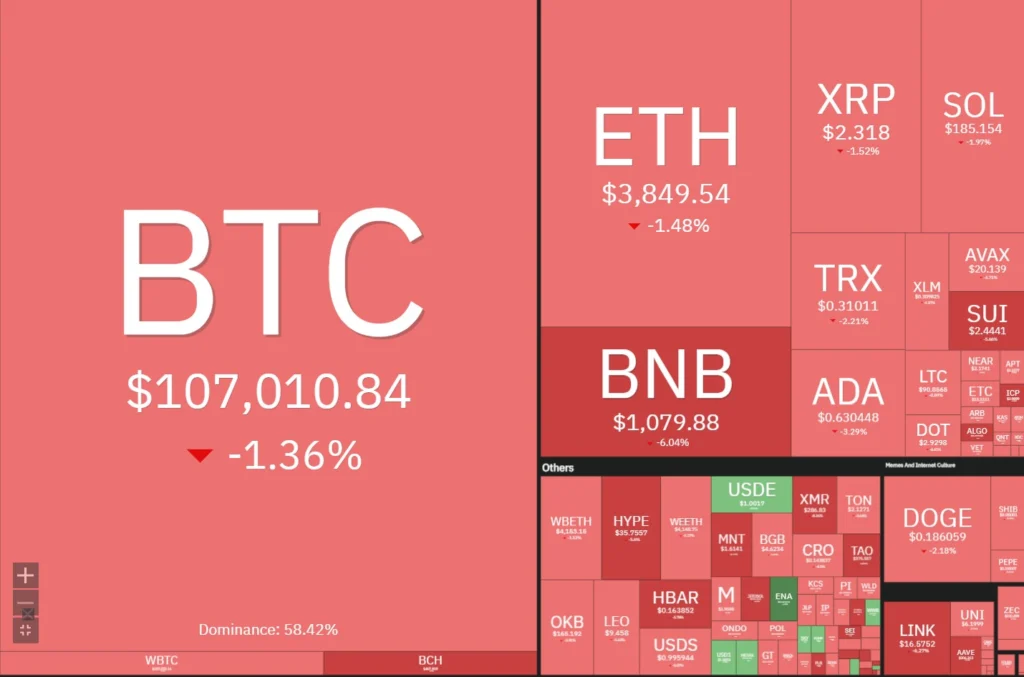
Source: Coin360
On October 10, 2025, President Donald Trump announced a 100% tariff package on China’s tech exports, along with new restrictions on critical software.
The decision came as a response to China’s limits on exporting rare minerals — key materials for semiconductors and electronic equipment.
The move shook global markets and triggered a wave of mass liquidations in cryptocurrencies. According to Reuters, Bitcoin plunged about 8.4%, hitting $104,782, while Ethereum dropped nearly 6% the same day.
Within hours, over $19 billion in leveraged positions were liquidated across exchanges, amplifying the market downturn.
Why Trump’s Announcement Crashed Crypto
1. Fear in Global Markets
The tariffs were seen as a major escalation in the U.S.–China trade war, reigniting fears of a global recession and disruptions in tech supply chains.
Investors moved toward safer assets, selling off cryptocurrencies and tech stocks.
2. Chain Reaction on Exchanges
The crypto market operates with high leverage.
When Bitcoin’s price dropped sharply, derivative positions (futures and perpetuals) were automatically liquidated, triggering a cascade effect that deepened the losses.
3. Strong Dollar and Risk Aversion
The geopolitical tension strengthened the U.S. dollar (DXY), reducing appetite for alternative assets such as Bitcoin and altcoins.
Uncertainty grew further when China announced it might impose retaliatory tariffs, heightening global risk aversion.
Trump’s Speech and Political Impact
According to Reuters and The Guardian, Trump justified the tariffs as a way to “protect America’s technology industry” and a “necessary response” to China’s trade practices.
However, days later, the former president admitted that 100% tariffs are “not sustainable in the long term,” suggesting an openness to renegotiate with Xi Jinping in the coming weeks.
Despite this attempt at moderation, the damage was done: global investor confidence plummeted, and the crypto market — highly sensitive to macroeconomic shocks — reacted with intense volatility.
Crypto Market Faces Massive Liquidations and Record Losses in October 2025
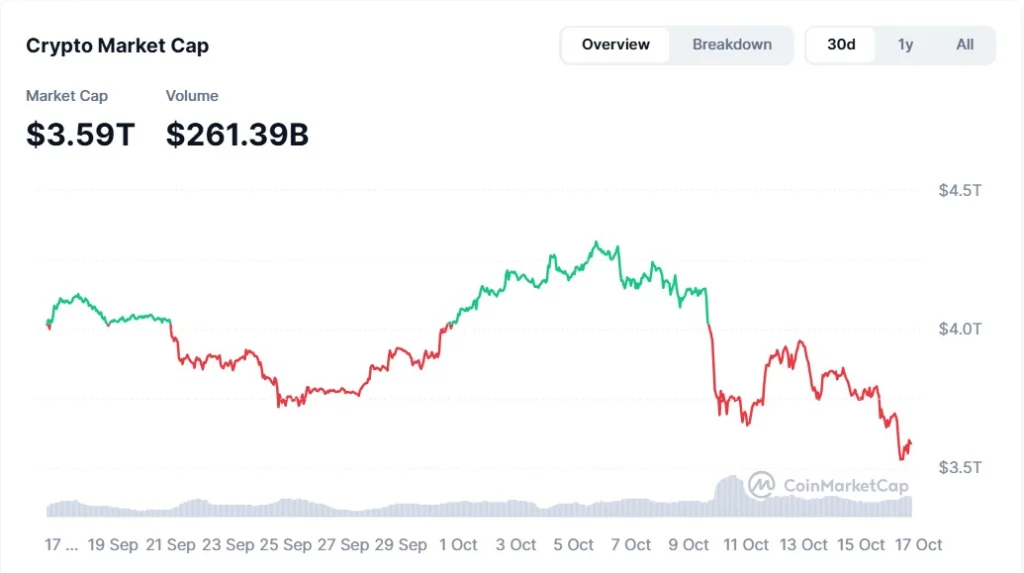
Source: cointelegraph
The cryptocurrency market went through one of the largest liquidation waves of 2025, with billions of dollars wiped out within hours.
The main trigger was Donald Trump’s announcement on October 10 of 100% U.S. tariffs on Chinese tech exports — a decision that rattled global stock markets, commodities, and digital assets.
The trade escalation between the two superpowers fueled global risk aversion, prompting traders to close leveraged positions and causing a domino effect across major cryptocurrencies.
Record Liquidations: Over $19 Billion in a Single Day
According to The Economic Times, the crypto market saw more than $19 billion in liquidated futures contracts and leveraged positions — one of the highest figures in recent history.
In just 24 hours, over $1 billion in long (bullish) positions were automatically closed.
Bitcoin and Ethereum accounted for nearly $730 million of these liquidations — with $453 million from BTC and $277 million from ETH.
At the peak of the sell-off, Bitcoin plunged 8.4% to $104,782, while altcoins like Solana, XRP, and Cardano dropped as much as 17%.
Gulf News also reported an additional $147 million in liquidations when BTC broke below the $108,000 support level.
Impact on Bitcoin, Altcoins, and ETFs
Bitcoin and Ethereum
- BTC fell from $122,000 to $104,000 in just three days.
- ETH lost its $3,800 support level, declining more than 9%.
- Bitcoin dominance temporarily increased as traders sought relative stability.
Altcoins
- Solana (SOL) and Cardano (ADA) dropped between 15% and 20%.
- DeFi and Layer-2 tokens suffered intense liquidations in derivative pools.
ETFs and Institutional Market
- U.S. Bitcoin and Ethereum ETFs recorded significant outflows, particularly from Fidelity and ARK 21Shares funds — reflecting growing institutional caution.
Consequences and Lessons from the Crash
- Increased volatility: funding rates and option premiums surged.
- Liquidity crunch: exchanges tightened leverage limits and raised margin requirements.
- Risk aversion: traders moved to stablecoins (USDT, USDC) and reduced exposure.
- Mining sector hit: companies like Bitfarms and Hive Blockchain saw sharp declines after disclosing debt and convertible note issuances.
- Strategy shift: investors are now favoring spot trading and hedged derivatives.
What to Expect Going Forward
- Gradual recovery: with lower leverage, the market may stabilize in the short term.
- Focus on the Fed and macro data: U.S. interest rate and inflation decisions remain key price drivers.
- Liquidity watch: sustainable rebounds depend on renewed institutional confidence.
- Buyback opportunities: analysts highlight the $100K–$107K zone as a potential long-term entry range.
Crypto Fear & Greed Index Falls to April Levels as Market Loses $230 Billion in a Day
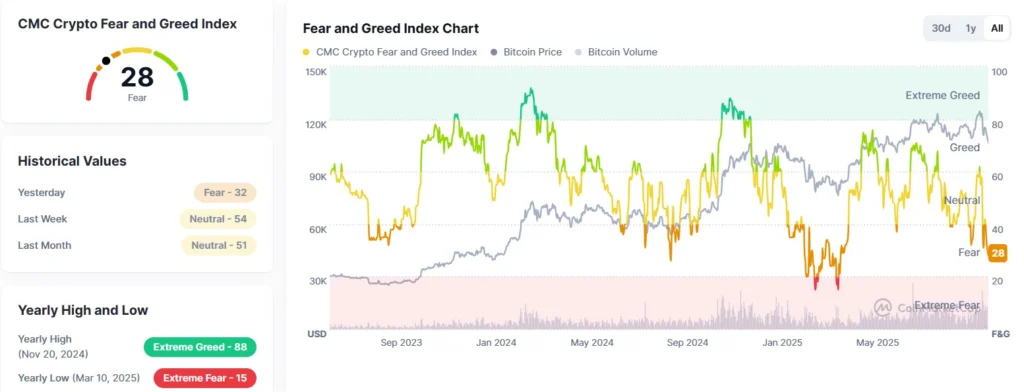
Source: coinmarketcap
The Crypto Fear & Greed Index plunged to 28 points, signaling “fear” — its lowest level since April 2025.
According to CoinMarketCap, the total cryptocurrency market capitalization dropped from $3.78 trillion to $3.54 trillion, erasing more than $230 billion in just 24 hours.
This decline reflects a broad loss of confidence, as traders reduced exposure amid macroeconomic uncertainty and ETF outflows.
Among the top 100 cryptocurrencies (excluding stablecoins), the average drop ranged between 8% and 9%, marking one of the sharpest daily corrections since mid-2024.
NFTs, Memecoins, and ETFs Also Decline
The sell-off extended beyond major cryptocurrencies:
- Memecoins lost 33% of their total market value.
- Leading tokens like DOGE and PEPE dropped around 10%.
- The NFT market fell below $5 billion, with “blue-chip” collections posting double-digit losses.
- Spot Bitcoin ETFs saw $536 million in outflows, while Ether ETFs recorded $56 million in redemptions.
These figures show that even institutional investors are trimming exposure to digital assets amid heightened uncertainty.
Traditional Markets Reflect the Fear
The Traditional Fear & Greed Index, which tracks sentiment in stocks and bonds, also fell to 22 points, indicating “extreme fear.”
This move reflects global risk aversion driven by economic slowdown, tightening credit conditions, and geopolitical tensions between the U.S. and China — all factors that frequently weigh on the crypto sector.
What This Means for Investors
An index reading below 30 typically signals a bearish phase, dominated by panic selling and risk aversion.
Historically, such drops have preceded accumulation periods, when long-term investors begin buying assets at discounted prices.
However, short-term volatility is expected to persist — particularly among altcoins, memecoins, and NFTs, which tend to amplify both gains and losses.
Gold Soars to All-Time High
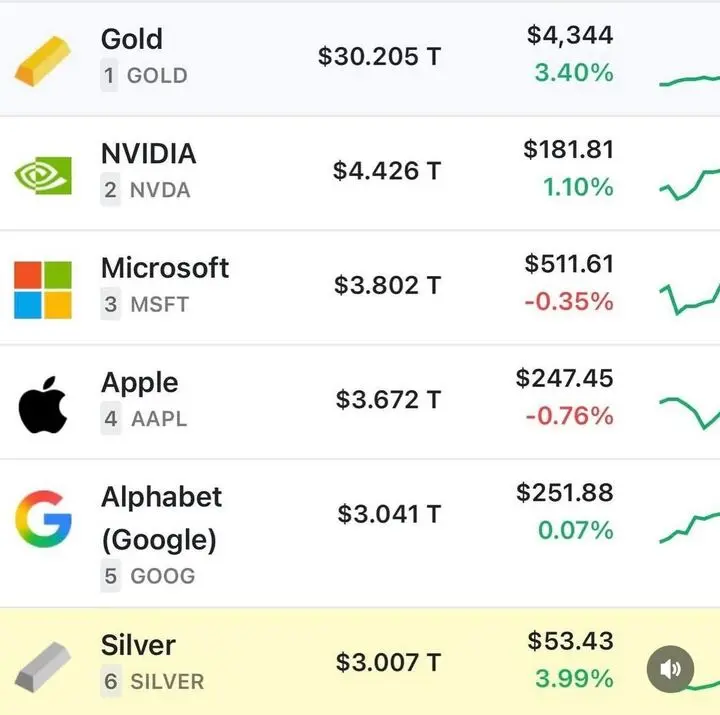
Source: cointelegraph
Gold ended the week with a sharp rally, surpassing $4,300 per ounce and marking its best weekly performance since the 2008 financial crisis.
The precious metal gained around 8% over the period, driven by demand for safe-haven assets, a weaker U.S. dollar, and growing expectations of interest rate cuts by the Federal Reserve (Fed).
According to Reuters, gold reached $4,379/oz on October 17, while the SPDR Gold Trust, the world’s largest gold-backed ETF, recorded record inflows, reflecting strong institutional demand.
What’s Behind Gold’s Surge
1. U.S.–China Tensions
The increase in U.S. tariffs on Chinese tech products heightened global risk sentiment, prompting investors to seek safety in gold.
2. Fed Rate Cut Expectations
Expectations that the Federal Reserve will lower interest rates in the coming months boosted the metal’s appeal.
With lower rates, the opportunity cost of holding gold decreases, making it more attractive to funds and long-term investors.
3. Weaker U.S. Dollar
The U.S. Dollar Index (DXY) declined throughout the week, supporting gold prices — which tend to rise when the dollar weakens.
A cheaper dollar makes precious metals priced in USD more affordable for global buyers.
4. Institutional Flows and ETFs
Gold investment funds such as the SPDR Gold Trust saw strong inflows, showing that the rally is backed not only by speculation but also by solid institutional allocation.
5. Rising Physical Demand
Asian markets, especially India and China, reported growing demand for physical gold — both for cultural reasons (festive season buying) and currency protection.
Gold vs. Bitcoin: Safe Haven vs. Risk Asset
While gold surged, the crypto market suffered massive liquidations, with over $19 billion in positions wiped out.
This contrast underscores gold’s role as a safe-haven asset during periods of uncertainty, whereas cryptocurrencies like Bitcoin remain more correlated with risk assets.
Investors seeking diversification often balance exposure between gold and crypto, using the metal as a natural hedge against volatility.
U.S. Seizes $14 Billion in Bitcoin — Portion May Go to National Strategic Reserve

The U.S. Department of Justice (DoJ) has confirmed the largest Bitcoin seizure in history: more than $14.4 billion in BTC confiscated from Chen Zhi, accused of running a global fraud and money-laundering network.
According to Portal do Bitcoin, this operation brings the total amount of cryptocurrency held under U.S. government custody to roughly $22 billion in BTC, based on data from Arkham Intelligence.
Seized Bitcoins Could Join a U.S. Strategic Reserve
The news reignites debate around creating a national Bitcoin strategic reserve — a proposal supported by some American politicians, including former President Donald Trump.
The idea is to incorporate part of the Bitcoin seized in criminal operations into the U.S. national reserves, functioning as a kind of “sovereign digital gold.”
However, there is still no official decision regarding the fate of the funds.
A portion may be allocated to compensate victims of the fraud, depending on court rulings.
What Is the Bitcoin Strategic Reserve?
The so-called Bitcoin Strategic Reserve would be a state-held BTC stockpile managed by the government — similar to how countries store gold or U.S. Treasury bonds.
Experts believe that if implemented, such a policy could:
- Strengthen the U.S. role as a global leader in digital assets.
- Provide monetary diversification amid inflation and dollar fluctuations.
- Grant institutional legitimacy to Bitcoin as a store of value.
On the other hand, critics warn about the volatility risks of BTC, custody challenges, and the complexities of managing a decentralized asset through public institutions.
Legal and Operational Challenges
Despite the record-breaking seizure, the U.S. government faces several legal and logistical hurdles before deciding what to do with the Bitcoins:
- Ongoing legal proceedings: part of the assets may be used to compensate Chen Zhi’s victims.
- Volatility risks: Bitcoin’s price fluctuations can drastically impact the reserve’s total value.
- Security and custody: requires advanced cold wallet protocols to ensure safe storage.
- Transparency and auditing: funds must remain traceable and verifiable, preventing misuse or loss.
U.S. Expands Its Footprint in the Global Crypto Market
With this seizure, the U.S. government now holds one of the largest Bitcoin reserves in the world — surpassing corporate holdings like MicroStrategy and Tesla.
The move strengthens the United States’ regulatory and strategic influence over the crypto ecosystem while raising an important question:
Should Bitcoin be treated as a strategic state asset, just like gold?
This discussion is likely to intensify as institutional crypto adoption grows and governments around the world pursue digital sovereignty strategies.
New York Establishes the First U.S. Office for Blockchain and Digital Assets
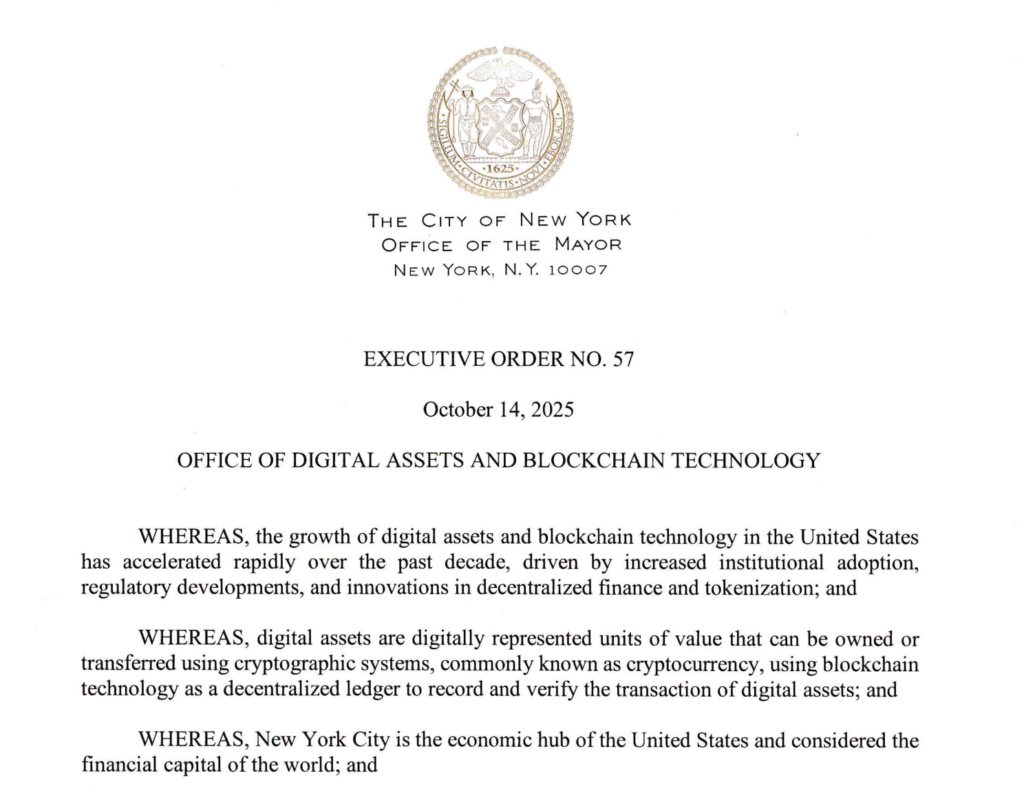
Executive order by New York City Mayor Eric Adams creating the “Office of Digital Assets and Blockchain Technology.” Source: NYC.gov
On October 14, 2025, Mayor Eric Adams signed Executive Order 57, establishing the Office of Digital Assets and Blockchain — the first municipal office in the United States dedicated exclusively to blockchain technology and digital assets.
The office will report to Matthew Fraser, the city’s Chief Technology Officer (CTO), and will work in collaboration with the New York City Office of Technology and Innovation.
Its mission is to position New York as a global hub for crypto innovation, attracting companies, talent, and investment to the sector.
Moises Rendon, a former blockchain policy advisor for the city government, was appointed as the director of the new office.
One of the first initiatives will be to form a commission of digital asset experts to assist in the development of blockchain-related policies and regulations.
Mission and Objectives of the Office of Digital Assets and Blockchain
According to the NYC Government and Cointelegraph, the new office aims to:
1. Promote the responsible use of blockchain technology
Encourage ethical and secure adoption of crypto assets in both public and private services, with a focus on transparency, innovation, and regulatory compliance.
2. Attract global talent and investment
Position New York as a competitive center for blockchain startups and enterprises, driving economic and technological growth in the digital asset sector.
3. Connect government and the crypto industry
Build bridges between public institutions and the crypto ecosystem, facilitating pilot projects, partnerships, and collaborative innovation policies.
4. Modernize public services through blockchain
Integrate decentralized solutions into city processes — such as digital identity, smart contracts, and property registries — to improve efficiency and transparency.
5. Educate and protect citizens
Launch awareness programs about fraud prevention, scams, and best practices in using digital assets.
6. Expand financial inclusion
Provide safe alternatives for access to digital financial services for unbanked and underbanked communities.
Challenges and Limitations of New York’s Blockchain Office
Despite being a major milestone for the crypto industry, the project faces several challenges in the state’s regulatory environment:
1. Stringent BitLicense framework
New York still enforces the BitLicense, considered one of the strictest crypto regulations in the U.S.
According to CCN and Cointelegraph, the high costs and bureaucracy associated with obtaining the license have driven many startups away from the state.
While the Office of Digital Assets and Blockchain cannot revoke state laws, it can facilitate dialogue between the government and the private sector to help reduce local barriers.
2. Political and budget limitations
As a municipal agency, the office’s influence and funding depend on the city’s budget and political support — factors that will determine its real impact.
3. Coordination across government levels
To establish New York as a global blockchain hub, policies will need alignment with state and federal agencies such as the SEC and CFTC.
4. Political perception and timing
Some analysts view the initiative as part of Mayor Adams’ legacy agenda, with his term set to end in January 2026.
5. International competition
New York faces strong competition from Miami, London, Dubai, and Singapore, cities already known for more flexible Web3 and blockchain regulations.
Expected Impact on the Crypto Ecosystem
If effectively executed, the Office of Digital Assets and Blockchain could turn New York into a public innovation lab for Web3.
Potential outcomes include:
- Providing a formal channel of communication between crypto companies and city officials.
- Enabling public-sector blockchain applications in traceability, digital identity, and smart contracts.
- Attracting startups and venture capital focused on crypto infrastructure.
- Creating a clearer and more collaborative regulatory environment for smaller blockchain firms.
- Strengthening New York’s image as America’s financial and technological capital in the digital era.
The creation of the Office of Digital Assets and Blockchain marks a historic step for the institutional adoption of blockchain technology in the United States.
If the initiative successfully balances regulation, innovation, and financial inclusion, New York could emerge as the leading crypto hub in the Americas, bridging its financial legacy with the future of the digital economy.


